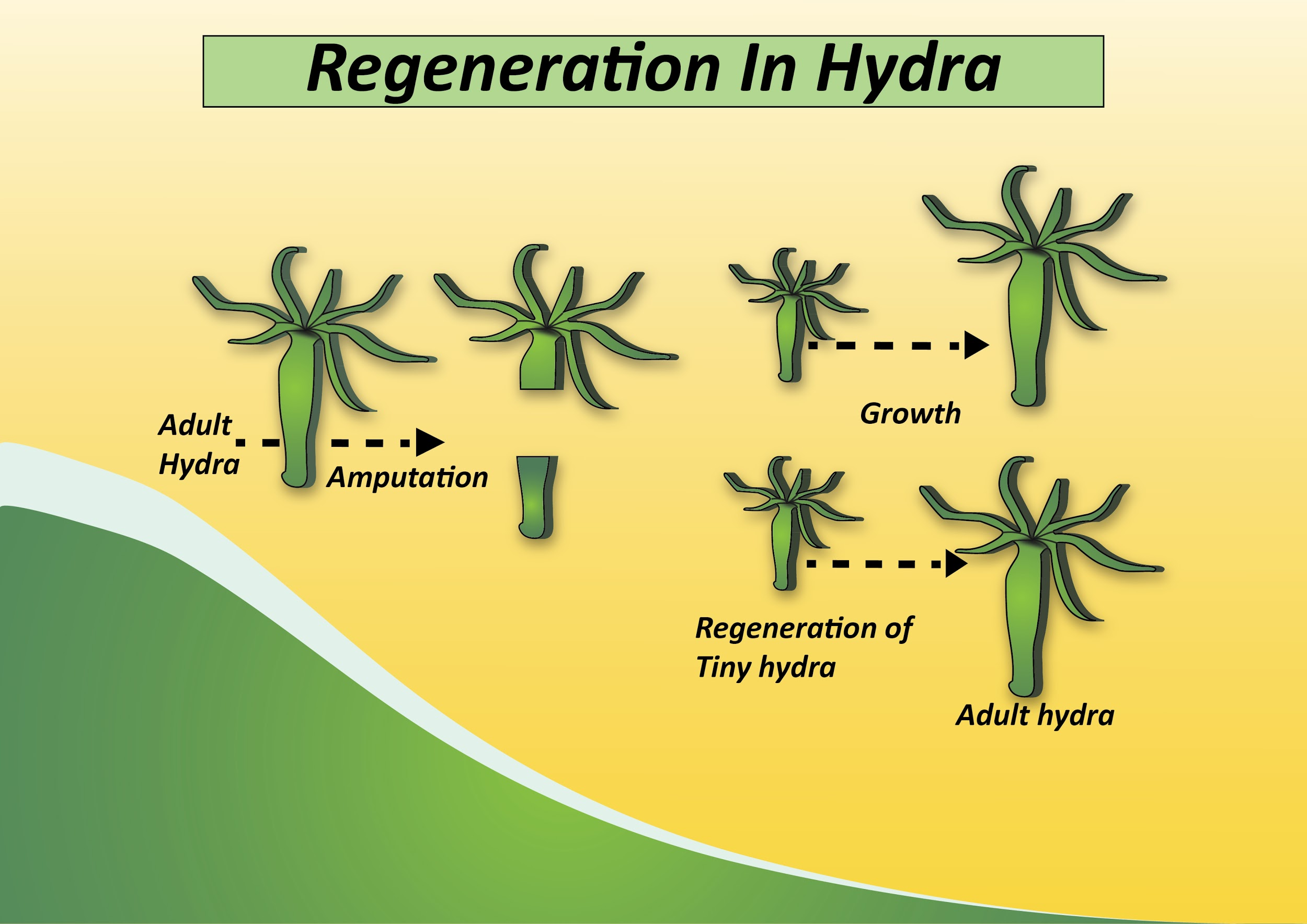
Explain the term ‘regeneration’ as used in reproduction in organisms. Describe briefly how regeneration is carried out in multicellular organisms like a Hydra.
Answer
493.8k+ views
Hint: Regeneration is a natural process of replacing or restoring damaged or missing cells, tissues, organs, and even whole body parts to full function in plants and animals. Scientists are researching regeneration for its possible applications in medicine, such as the treatment of a wide range of injuries and diseases.
Complete answer:
Regeneration is not the same as reproduction, since regeneration is just a form of asexual reproduction, whereas reproduction can be sexual or asexual. Regeneration is the mechanism by which an animal replaces a damaged portion of its body, including wound healing, tissue repair, and several forms of restorative behaviors.
Regeneration in Hydra- Hydra regeneration is polarised and does not rely on development. When cut in two, the lower part develops a head, and the upper part develops a foot. A piece removed from the body of Hydra will regenerate both the head and the basal disc in the same polarity. A small fragment will create a small Hydra, which will expand after feeding. Strong irradiated Hydra, which cannot undergo cell division (growth) will regenerate.

Additional Information: An organism such as Hydra uses regenerative cells for reproduction in the budding phase. When Hydra reaches maturity and is well fed, its body wall starts to form a rounded growth out of the adult stalk. This growth is called a bud that grows into a miniature Hydra in time. The body layers, the body cavity, and the digestive cavity of the young Hydra are continuous with that of the parent Hydra. The young Hydra has been fed by the parents. When the young Hydra is sufficiently established to have an autonomous life, the base of the new Hydra seals off and thus enables the new entity to break away from the parent Hydra.
Note: Characteristics that make a Hydra animal is that it is motile, multicellular, can reproduce asexually and sexually and is heterotrophic. Hydras are distinct from other Cnidarians in a way that alternates generations; medusa and polyp point. They have "sting cells" and they are predators.
Complete answer:
Regeneration is not the same as reproduction, since regeneration is just a form of asexual reproduction, whereas reproduction can be sexual or asexual. Regeneration is the mechanism by which an animal replaces a damaged portion of its body, including wound healing, tissue repair, and several forms of restorative behaviors.
Regeneration in Hydra- Hydra regeneration is polarised and does not rely on development. When cut in two, the lower part develops a head, and the upper part develops a foot. A piece removed from the body of Hydra will regenerate both the head and the basal disc in the same polarity. A small fragment will create a small Hydra, which will expand after feeding. Strong irradiated Hydra, which cannot undergo cell division (growth) will regenerate.

Additional Information: An organism such as Hydra uses regenerative cells for reproduction in the budding phase. When Hydra reaches maturity and is well fed, its body wall starts to form a rounded growth out of the adult stalk. This growth is called a bud that grows into a miniature Hydra in time. The body layers, the body cavity, and the digestive cavity of the young Hydra are continuous with that of the parent Hydra. The young Hydra has been fed by the parents. When the young Hydra is sufficiently established to have an autonomous life, the base of the new Hydra seals off and thus enables the new entity to break away from the parent Hydra.
Note: Characteristics that make a Hydra animal is that it is motile, multicellular, can reproduce asexually and sexually and is heterotrophic. Hydras are distinct from other Cnidarians in a way that alternates generations; medusa and polyp point. They have "sting cells" and they are predators.
Recently Updated Pages
Master Class 12 Business Studies: Engaging Questions & Answers for Success

Master Class 12 English: Engaging Questions & Answers for Success

Master Class 12 Social Science: Engaging Questions & Answers for Success

Master Class 12 Chemistry: Engaging Questions & Answers for Success

Class 12 Question and Answer - Your Ultimate Solutions Guide

Master Class 11 Economics: Engaging Questions & Answers for Success

Trending doubts
Draw a labelled sketch of the human eye class 12 physics CBSE

a Tabulate the differences in the characteristics of class 12 chemistry CBSE

Which one of the following is a true fish A Jellyfish class 12 biology CBSE

Why is the cell called the structural and functional class 12 biology CBSE

Differentiate between homogeneous and heterogeneous class 12 chemistry CBSE

Write the difference between solid liquid and gas class 12 chemistry CBSE




